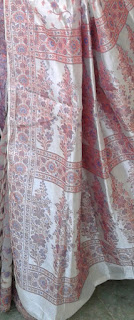Recently, we visited a handloom exhibition. The exhibition had stalls from nearly all the states of India. They showcased the traditional saris, dress materials, furnishing materials and accessories made from handloom.
The exhibition was held in a vast marriage hall. I had expected it to be filled with enthusiastic patrons, especially ladies! Alas, there were hardly five to six ladies including me, there. My husband was the odd man out.
 |
| A resplendent Kanjivaram sari |
The exhibition was held in a vast marriage hall. I had expected it to be filled with enthusiastic patrons, especially ladies! Alas, there were hardly five to six ladies including me, there. My husband was the odd man out.
Stacks of materials beckoned me in the hall that seemed to be bereft of any customers. The stall-owners expectedly, latched on to the stray customer who strolled over.
"Here, Madam, look here! Hand embroidered silk saris from West Bengal. 10 colors. Take your pick!"
From across, another stall-owner beckoned, rather desperately, "Bed-sheets, gowns, dupattas from Rajasthan! Please have a look Madam."
What was amazing was the sheer variety and volume of the handloom material exhibited there! There was a lone stall with exquisitely crafted wooden toys. Again, no customers! It struck me that India had such a vast repertoire of art and craft, but hardly any takers!
 |
| An elegant Banarasi sari |
 |
| An intricately woven Paithani sari |
What was amazing was the sheer variety and volume of the handloom material exhibited there! There was a lone stall with exquisitely crafted wooden toys. Again, no customers! It struck me that India had such a vast repertoire of art and craft, but hardly any takers!
To encourage artisans and handloom weavers, we could take to decorating our homes and offices with their products. We could gift these items to each other.
Students could wear handloom attire in their colleges. Competitions could be held to decide the most elegantly dressed person in college! I'm sure the judges would have a tough time as each handloom variety has a unique charm! Thus separate segments could be formed to decide the winners.
 |
| A dazzling Kanjivaram sari |
Each month, the handloom of a particular State could be chosen for a contest; thereby ensuring that all varieties get equal and assured prominence. All would get their place under the sun! Since we have 28 states and 8 Union territories, this contest would run for three whole years! Enough of excitement for the collegians!
Likewise offices and institutions could hold contests for their employees. Housing societies, supermarkets, banks, the list is endless...
Contests could be held by the National Handloom Development Council to get ideas regarding newer varieties, newer ways of presenting the materials, marketing and product development. Awards could be given to those designers who use indigenous material.
All ladies could wear handloom saris as often as they could, not restricting the ritual to functions and special occasions; if only to ensure that the glorious weaving tradition gets a much-needed fillip.
The weavers will then be able to sustain themselves and maintain their legacy!
Those ladies lucky enough to grace award ceremonies and red-carpet events could espouse the cause and be brand ambassadors too!
Let's revive the gorgeous, traditionally woven fabric materials and the ever- elegant handloom sari; and prompt the whole world to say "Wow!"
The copyright of this article is with Mrs. Priya Ramesh Swaminathan.
P.S. The snaps are of saris from my collection.
 |
| A magnificent Patola sari |
 |
| A gorgeous Banarasi sari |
The copyright of this article is with Mrs. Priya Ramesh Swaminathan.
P.S. The snaps are of saris from my collection.
No comments:
Post a Comment